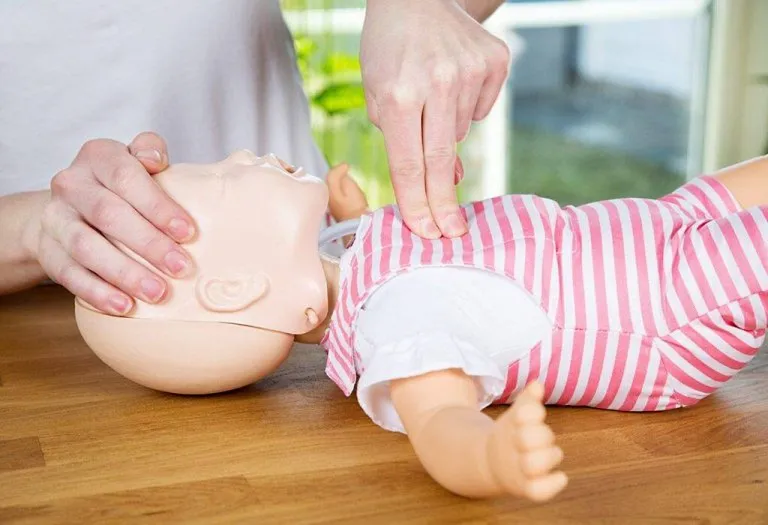Choking and gagging are some of the common mishaps that infants are prone to. Choking is different from gagging by a few parameters. Gagging is a natural reflex, and it is located farther down the mouth. Gagging is a protective reflex to prevent choking.
Play The Quiz And Win Exciting Prizes
Play The Quiz And Win Exciting Prizes
Play The Quiz And Win Exciting Prizes
Play The Quiz And Win Exciting Prizes
Choking can be partial or total. With partial choking, the child is able to cough and will participate in removing the foreign body, while with total choking, the airways get obstructed. If a baby is coughing effectively when choking, it is best to let the coughing continue as it will help clear the airway. However, if that is not the case, knowing first aid and effective ways to quickly clear a blocked airway can save the baby’s life. Read on to learn more about baby choking and CPR.
What Is Choking in Babies?
Choking in babies refers to a situation where a baby’s airway becomes partially or completely blocked, making it difficult for them to breathe. This can occur when food, small objects, or liquids accidentally block the airway. Since babies are still learning how to eat and swallow, they are more vulnerable to choking hazards. Choking can lead to suffocation if the blockage is not quickly cleared.
Play The Quiz And Win Exciting Prizes
Play The Quiz And Win Exciting Prizes
Play The Quiz And Win Exciting Prizes
Play The Quiz And Win Exciting Prizes
How to Know If a Baby Is Choking
The following symptoms in a baby can be characteristics of choking:
- The universal sign of choking is hands clutched to the throat.
- Difficulty in breathing.
- Skin colour turns bluish.
- Loss of consciousness due to windpipe blockage.
- High-pitched sounds while inhaling.
- Inability to make any sound or cry uninterrupted.
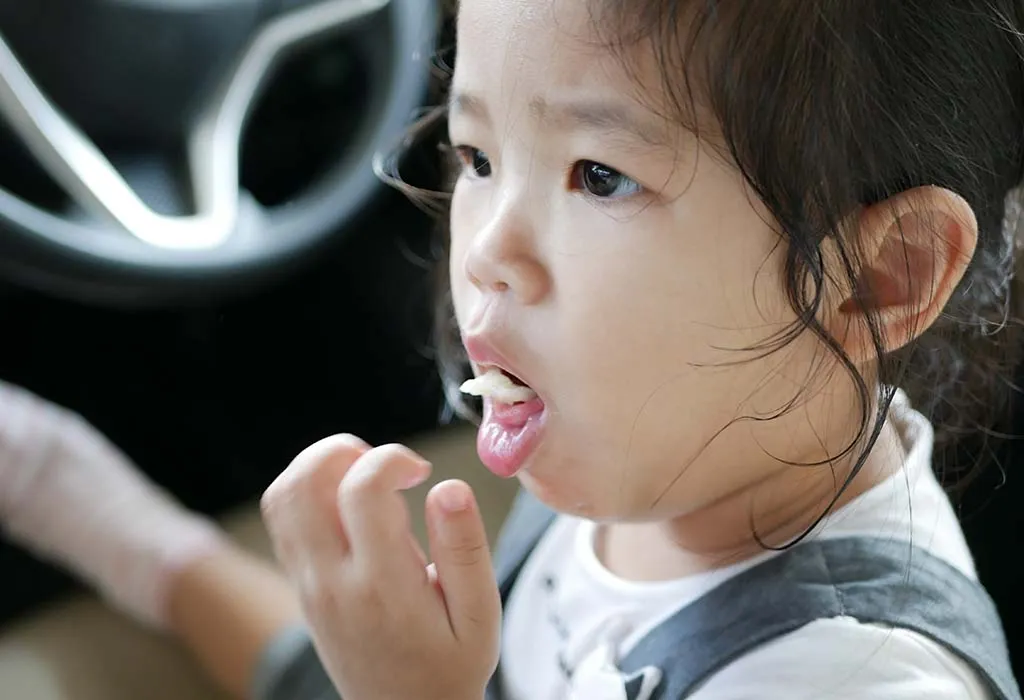
How to Save a Baby From Choking
Acting spontaneously is of utmost importance to prevent a choking baby from severe harm. Here are a few important steps to follow if a baby chokes:
1. Analyse the Situation Quickly
This is the first step when it comes to what to do if an infant is choking. If a baby cannot breathe, cough or cry, it might be because something is blocking his airway. Several symptoms, such as those mentioned above, can help identify if the baby is choking. A quick analysis of the situation will aid in saving his life.
2. Clear the Blockage
Clearing the blockage promptly is necessary to allow babies to breathe normally and feel relieved. When a baby shows symptoms of choking, use one finger to lift the chin and take a look into his mouth and nose to remove any visible blockage or obstruction. If the baby is coughing, allow him to cough until the obstruction comes out. Do not pat the back while a baby coughs as this will allow the obstruction to slip further inside.

3. Back Blows and Chest Thrusts
In a choking but responsive infant less than one-year-old, back blows and chest thrusts are used instead of abdominal thrusts, which we have also elaborated in the next point.
To provide back blows and chest thrusts, do the following:
- Hold the infant in your lap, with his face down and head lower than his chest. The baby should be resting on your forearm. Put your forearm on your thigh.
- Support the infant’s head and neck with your hand and be sure to avoid putting pressure on his throat.
- Using the heel of your free hand, deliver five back blows between the infant’s shoulder blades.
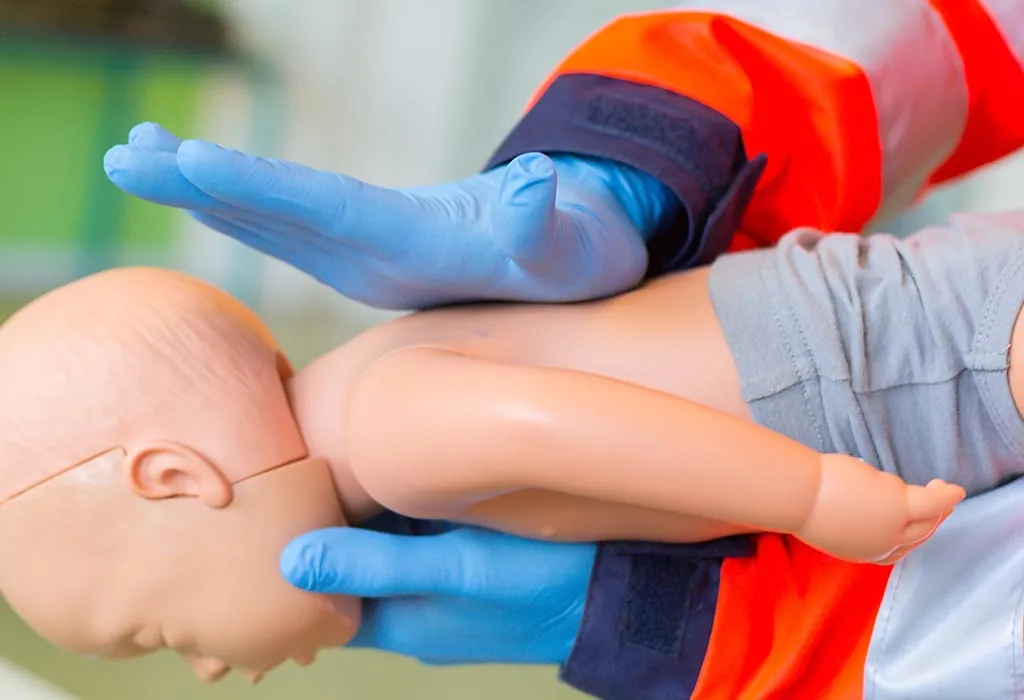
- Using both hands and arms, turn the infant face up, so he is now resting on your other arm. This arm should now be resting on your thigh.
- Once again, make sure the infant’s head is lower than his chest.
- Using the fingers of your free hand, give up to five quick downward chest thrusts (one thrust every second) over the lower half of the breastbone.
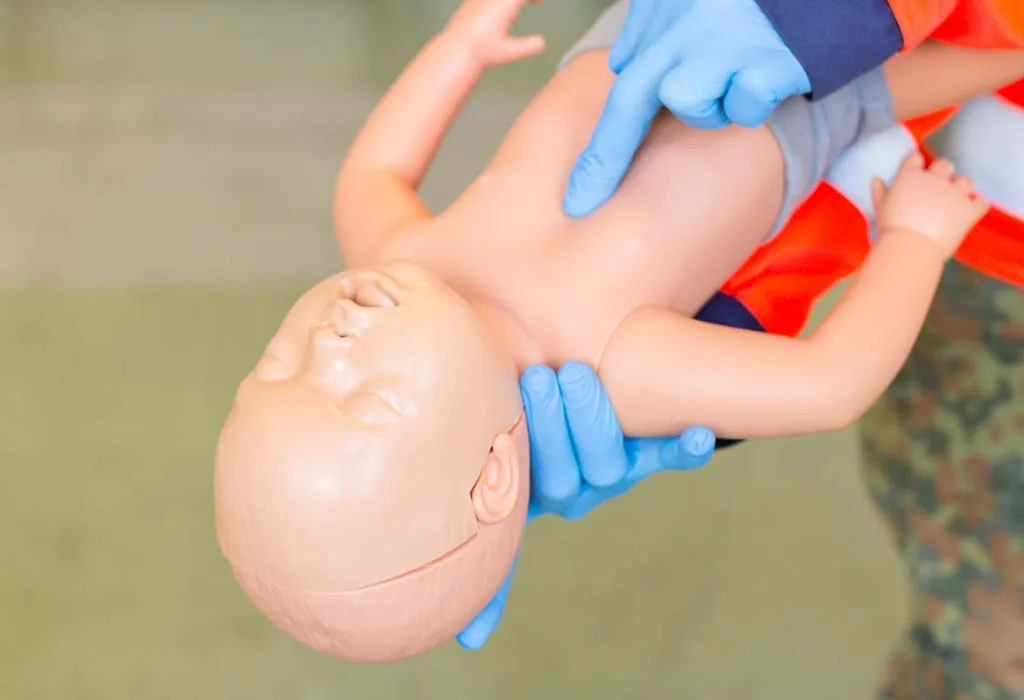
- If the obstruction is not relieved, turn the infant face down on your other forearm and repeat the process.
- Continue doing these steps until the infant begins to breathe or becomes unresponsive.
4. Abdominal Thrusts
These steps should only be used when a kid is responsive and older than
one year of age.
To properly perform the abdominal thrusts, do the following:
- Stand behind the responsive kid. Wrap your arms around his waist under the ribcage.
- Put the side of your fist above the kid’s navel in the middle of their belly. Do not press on the lower part of the sternum.
- With your other hand, hold the first fist and press forcefully into the kid’s abdomen and up toward his chest.
- Continue performing these thrusts until the obstruction is relieved or until the kid becomes unresponsive.
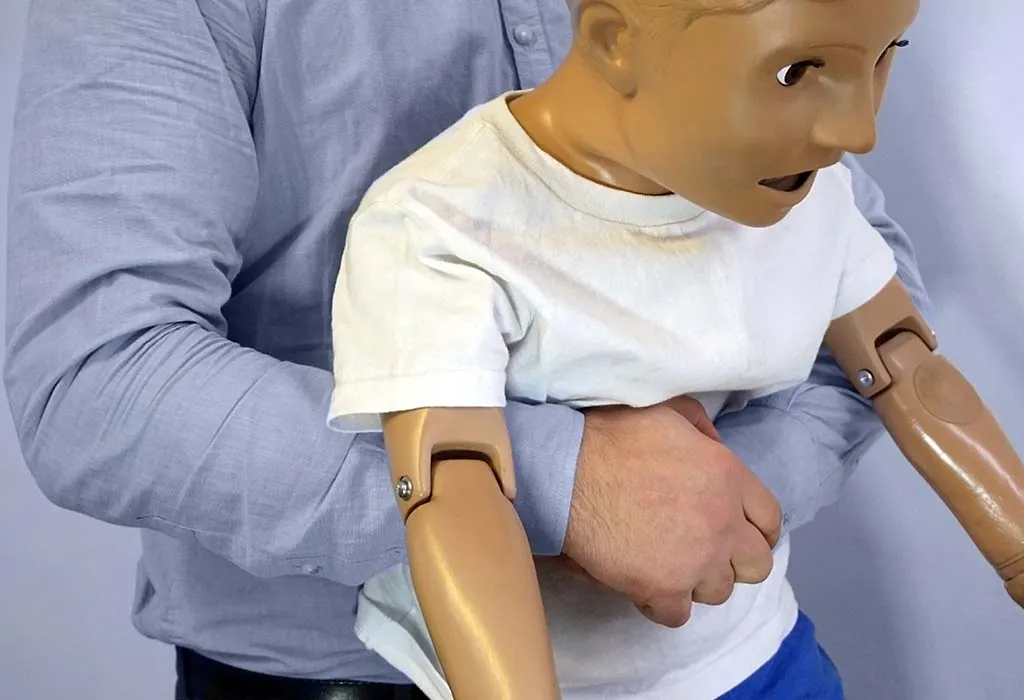
First Aid for Choking in Babies
Infants and babies are sensitive and prone to incidents such as choking, which is why they need to be handled with care at all times. Parents or guardians MUST know what to do if a baby chokes to provide immediate relief and prevent catastrophic consequences.
Food is a common choking hazard as young children might not be able to chew their food well and swallow it instead. It is important to understand the symptoms of choking so that the child can be given immediate and effective first aid.
When the baby is unresponsive or unconscious, and his breathing or heartbeat stops even after providing first aid for choking, you must provide CPR (Cardiopulmonary Resuscitation) and seek immediate medical attention. Continue reading to understand what CPR is and how it is done.
What Is CPR?
CPR or Cardiopulmonary Resuscitation is a life-saving procedure performed when a person’s heartbeat or breathing stops and shows no signs of life. CPR involves forceful rescue breathing that provides oxygen to the lungs. The procedure also involves chest compressions which help with the blood flow.
These procedures should continue until the child recovers or medical aid arrives, as lack of oxygen or stoppage of blood flow can result in permanent damage to the child. CPR for infants should ideally be done by someone who is trained with a CPR accredited course, but this can be done by parents too. Therefore, it is imperative to know the techniques in order to stay fully equipped in case a situation demands this to be performed.
What Calls for CPR in Babies
As discussed earlier, CPR is performed when the body shows no signs of life, i.e., the baby has stopped breathing, or his heart has stopped beating. The CPR procedure should be performed when all other methods of reviving the child fail. It is often done to restore blood circulation and flow of oxygen in babies or kids who have had cardiac arrests or suffered from choking, suffocation, shock, serious injury and other severe accidents.
A CPR procedure should be performed on a child if any of the following symptoms are noted:
- When there is no breathing.
- If the child has no pulse.
- If the child is unconscious.
In case of an emergency, it is appropriate to call the ambulance at the earliest. If you are alone with the baby with causality, then knowing how to give a CPR could prove to be useful. Perform CPR for a minute and then call for an ambulance and repeat the procedure until the ambulance arrives. Following are the steps to be followed to perform CPR on a baby.
1. Analyse the Problem Quickly
Identify the problem by noticing the symptoms mentioned above. If the baby is not conscious, try to get a response by gently tapping the sole of the foot and by calling out his name. The entire process should be done under 10 seconds, preferably. If the baby is unconscious and has trouble breathing, open the airway, check his pulse and give rescue breaths.

2. Open the Airway and Check the Pulse
Look and listen for normal breathing by kneeling at a right angle to the baby’s chest. Push down the forehead, tilt the head back and lift the chin with one hand. Now look for and remove any obstruction in the mouth and the nose. Check for the pulse on the inside of the elbow by using your middle and index finger. If there is no pulse or the baby is not breathing, call for help/ambulance right away and perform CPR.

3. Give Two Rescue Breaths
Follow these steps to give rescue breaths to the baby:
- Open the baby’s airway and ensure that it is clear.
- Seal your lips around the baby’s nose and lips, blow steadily into the baby’s lungs and see if it rises as you blow the air.
- Once the chest rises, stop blowing and allow it to fall.
- Repeat this process two times.

4. Give 30 Chest Compressions
- Place the baby on a firm surface and find the centre of his chest.
- Find the midpoint on the sternum, between an imaginary line joining the nipples and where the lowest ribs join in the middle.
- Press down to a third of the depth of the chest. Press 30 times at the rate of 100 compressions per minute.
- Give two rescue breaths after 30 compressions.
- Repeat this cycle of 30 compressions and 2 breaths, at least five times, or until help arrives.
These were the infant CPR steps.

When performing CPR on a baby, one must follow these precautionary measures:
- Do not start the CPR process if the child has signs of normal breathing, movement or coughing as doing so may cause the heart to stop beating.
- If you are not trained to perform CPR or do not have a basic understanding of how to perform CPR, seek professional help immediately and do not attempt to give CPR by yourself.
- If the child has a spinal injury, do not move the head or neck while pulling the jaw forward, and do not let the mouth close.
Tips to Prevent Choking in Babies
Most accidents that require CPR are preventable if suitable precautions, such as the ones given below, are taken:
- Ensure that you offer mashed or pureed food to your baby when you start feeding solids up until the baby begins teething and can consume finger foods.
- Avoid using the teething medication as it may numb the baby’s throat and make swallowing difficult.
- When the baby starts eating solid foods, ensure he is sitting up for his meals.
- Make sure all vegetables are soft-cooked.
- Finger food should be cut into small pieces.
- Encourage the child to eat slowly and chew well.
- Choose snacks that are easy to swallow.
- Keep small objects like buttons and seeds out of reach.
- Above all, keep an eye on your child, especially when he is eating, as he may not be able to alert you if he is choking.
In case of an emergency, it is best to call for medical help without delay. If your child suffers from a fatal accident, call for medical aid immediately and continue providing first aid while the team of professionals arrive.
FAQs
1. Can you perform CPR on an infant if they are unconscious but breathing?
If an infant is unconscious but still breathing, do not perform chest compressions. Instead, keep them in a safe position and call emergency services. If they stop breathing, begin infant CPR with chest compressions and rescue breaths. It’s critical to act quickly to provide the necessary support.
2. Can you use the Heimlich maneuver on a choking infant?
The Heimlich maneuver is not recommended for infants under the age of 1. Instead, a more appropriate method is the back slap and chest thrust technique. This involves holding the infant face-down on your forearm while delivering five back blows, followed by five chest thrusts to try and dislodge the object blocking the airway.
3. Can teething cause choking in infants?
While teething itself doesn’t directly cause choking, the process can lead to babies putting objects in their mouths to chew on. These objects, especially small ones, can become choking hazards if they break apart or if the baby tries to swallow them. Always monitor your baby closely when they are teething and ensure toys or objects they chew on are safe and appropriately sized.
4. Can excessive mucus in an infant’s throat lead to choking?
Excessive mucus, often from colds or respiratory infections, can sometimes cause babies to gag or choke, especially when they lie flat or are nursing. This is a less common cause but can be concerning for parents. Using a nasal aspirator or saline drops to clear the nasal passages can help reduce mucus buildup and lower the risk of choking.
Parents never compromise the health of their children. Knowledge of providing first aid can come handy when mishaps, such as choking, occur. It’s important to stay alert and observe your baby closely to prevent any incidents of baby choking while feeding, as it can occur if the baby is not positioned correctly or if food is swallowed too quickly. Although measures can be taken to prevent such accidents, if there’s a need, the information and tips provided in this article can help you manage the situation and seek medical help. Having said that, we strictly advise parents to avoid performing any techniques without being trained. A proper training under the guidance of a professional can help you ensure you are following the right methods whenever needed.
References/Resources:
1. Choking: First aid; Mayo Clinic; https://www.mayoclinic.org/first-aid/first-aid-choking/basics/art-20056637
2. Child & Baby CPR; American Red Cross; https://www.redcross.org/take-a-class/cpr/performing-cpr/child-baby-cpr
3. How to Perform CPR and Choking Relief for Infants; Singapore Heart Foundation; https://www.myheart.org.sg/techniques/cpraed-choking-for-infants/
4. Maebh. B, Dixon. M, Armstrong. C, Keane. F; The Pillow Project, Infant Choking, and Basic Life Support Training for Prospective Parents
A Low-Cost Intervention for Widespread Application; The Journal of Perinatal & Neonatal Nursing; https://journals.lww.com/jpnnjournal/Abstract/2019/07000/The_Pillow_Project,_Infant_Choking,_and_Basic_Life.15.aspx; September 2019
5. FAQ: Hands-Only CPR; American Heart Association; https://cpr.heart.org/-/media/cpr-files/courses-and-kits/hands-only-cpr/handsonly-cpr-faqs-ucm_494175.pdf
6. How to Help a Choking Child; Stanford Medicine; https://www.stanfordchildrens.org/en/topic/default?id=how-to-help-a-choking-child-1-197
7. First aid for a baby who is choking; British Red Cross; https://www.redcross.org.uk/first-aid/learn-first-aid-for-babies-and-children/choking-baby
Also Read:
Baby Gagging – Is It Normal?
Baby Choking While Breastfeeding
Guide to SIDS and Sleep Safety Measures for Infants
Was This Article Helpful?









